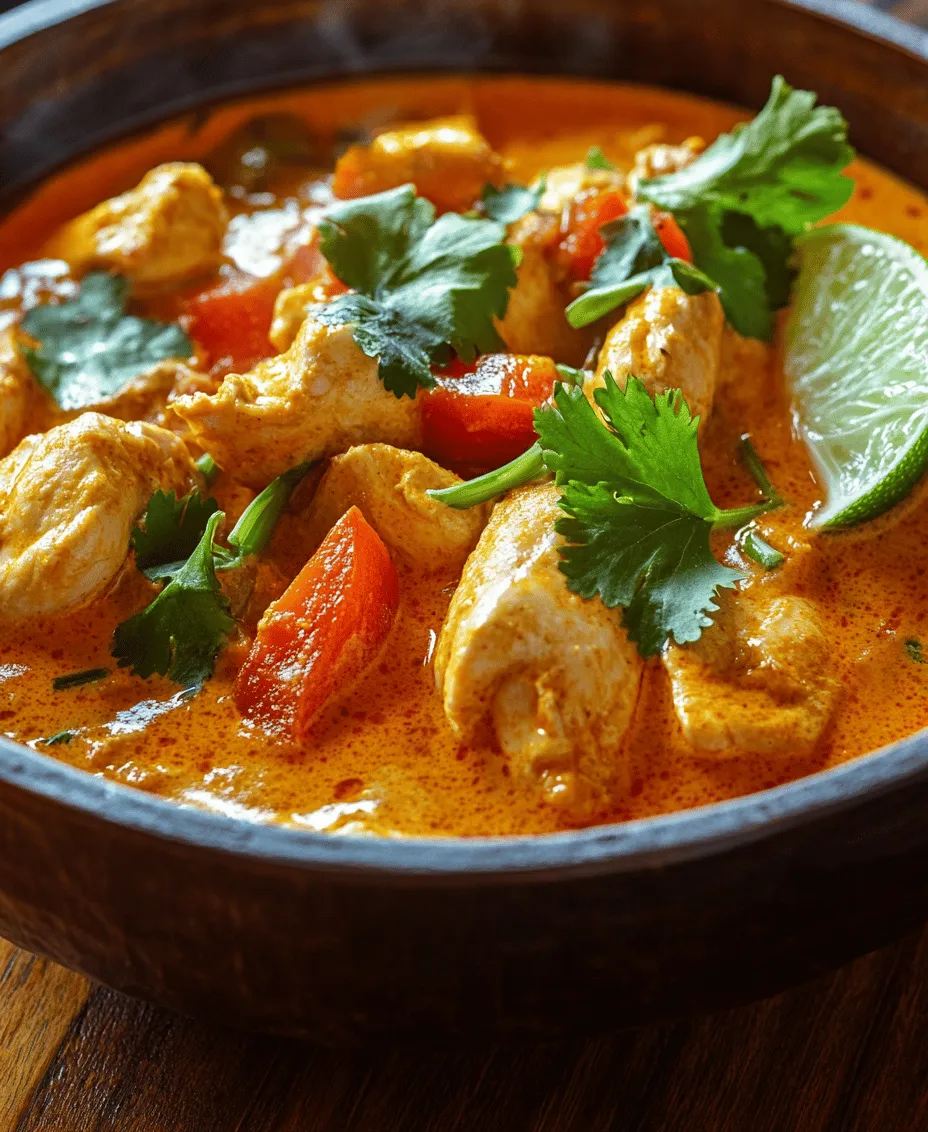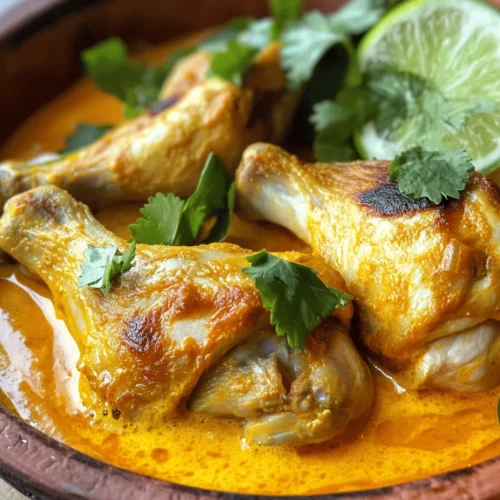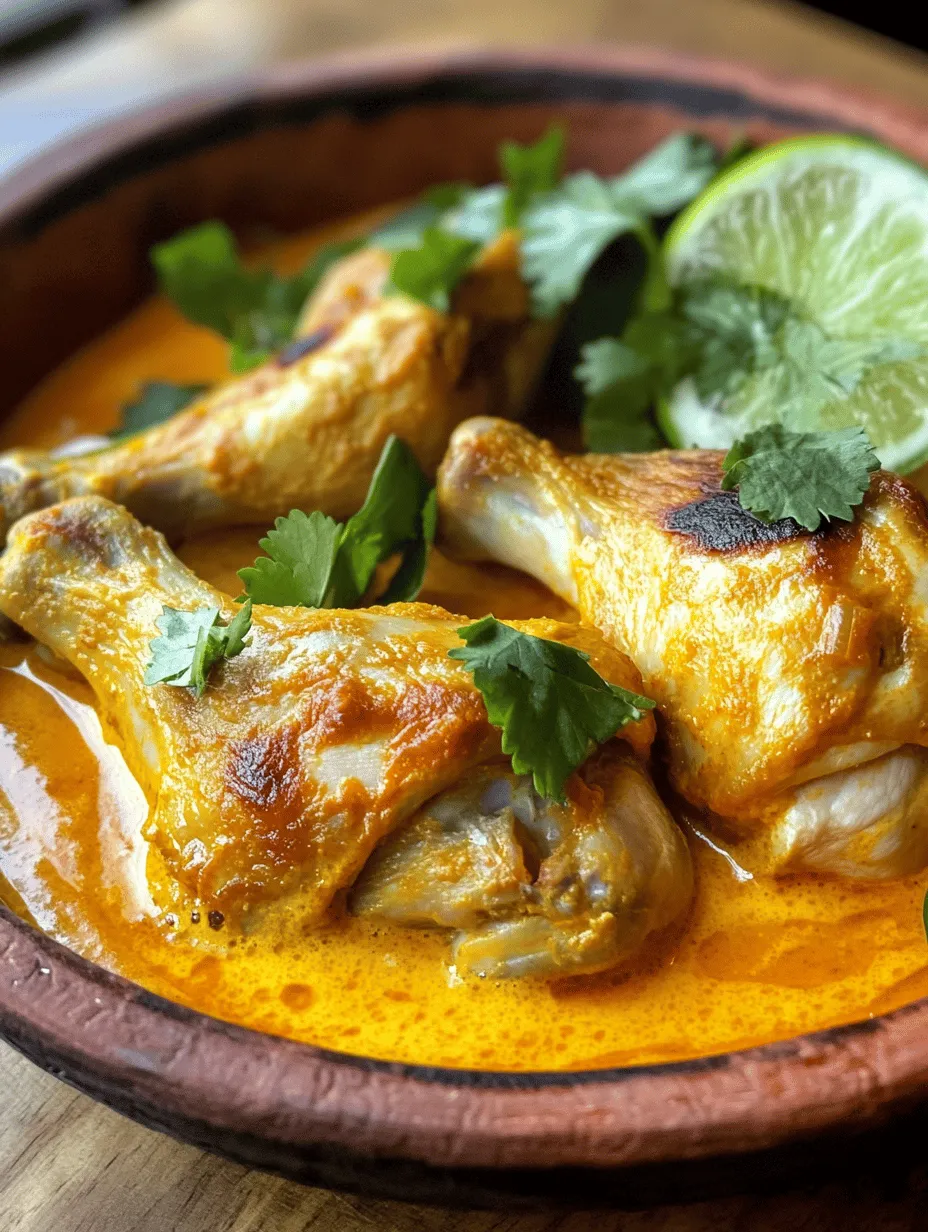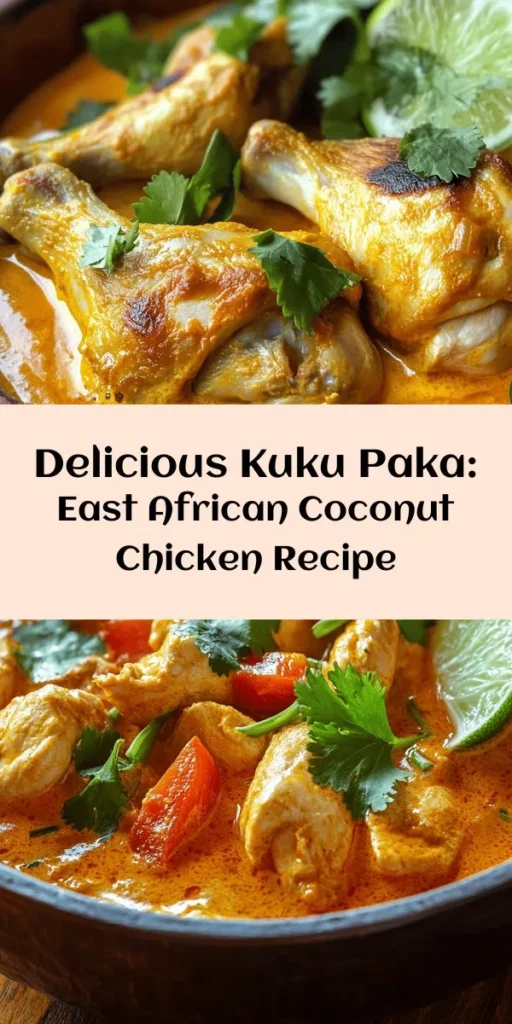Introduction
Kuku Paka, a beloved dish in East African cuisine, is a tantalizing chicken curry that seamlessly blends the rich flavors of coconut milk with an array of aromatic spices. This traditional meal is particularly popular in countries like Kenya and Tanzania, where it is often served on special occasions and family gatherings. The dish’s roots are deeply embedded in East African culture, showcasing a harmonious fusion of indigenous ingredients and culinary influences from the coastal regions.
Kuku Paka’s unique flavor profile makes it a standout comfort food, appealing to both locals and visitors alike. The creamy coconut milk forms the base of the sauce, creating a luscious texture that pairs beautifully with tender chicken. The spices used in the recipe offer not just flavor but also a glimpse into the region’s vibrant food heritage. As you embark on this culinary adventure, you’ll discover how the interplay of ingredients creates a dish that is both comforting and exciting.
Understanding Kuku Paka
The term “Kuku Paka” translates directly to “chicken in coconut” in Swahili, encapsulating the essence of this delightful dish. The evolution of Kuku Paka is tied to the history of trade and migration along the East African coast, where diverse culinary traditions merged. Influences from Arab, Indian, and indigenous African cuisines have all contributed to the distinctive character of this dish.
Originally, Kuku Paka was prepared with freshly caught fish, but over time, chicken became the favored protein, making it a staple in many households. The dish is often associated with coastal communities, where coconut palms thrive, and fresh seafood and spices are abundant. Today, Kuku Paka is not only a symbol of East African culinary tradition but also a representation of the region’s rich cultural tapestry.
A key aspect of Kuku Paka is its ingredient list, which plays a crucial role in defining the dish’s flavor and character. The combination of fresh ingredients and bold spices ensures that each bite is bursting with flavor, while also reflecting the agricultural bounty of the region.
Ingredient Breakdown
Whole Chicken
At the heart of Kuku Paka lies the chicken, and using a whole, fresh chicken is essential for achieving the best flavor and tenderness. The meat should be succulent and juicy, absorbing the rich coconut sauce beautifully. Opting for free-range chicken can enhance the dish’s overall taste, as it offers a richer flavor compared to conventional chicken. The bones also contribute to a more robust broth, making the sauce even more delicious.
Coconut Milk
Coconut milk is a star ingredient in Kuku Paka, imparting a creamy richness that elevates the dish. This versatile ingredient comes from the flesh of mature coconuts and is a common staple in East African cooking. It not only provides a delicious base for the sauce but also adds a subtle sweetness that balances the spices. Moreover, coconut milk is known for its health benefits, being rich in medium-chain fatty acids that can provide energy and support heart health.
Vegetables and Aromatics
The foundation of flavor in Kuku Paka is built upon a medley of vegetables and aromatics, primarily onions, garlic, and ginger. Onions add sweetness and depth, while garlic and ginger introduce a warm, aromatic quality that enhances the overall flavor profile. These ingredients are often sautéed at the beginning of the cooking process, allowing their flavors to meld and create a fragrant base for the dish.
Spices
A well-balanced spice blend is key to achieving the authentic taste of Kuku Paka. Common spices include turmeric, coriander, and cumin, each contributing unique flavors and health benefits.
– Turmeric: Known for its vibrant yellow color and earthy flavor, turmeric is celebrated for its anti-inflammatory properties and potential health benefits.
– Coriander: This spice adds a citrusy warmth, enhancing the dish’s complexity. It is also rich in antioxidants and may promote digestive health.
– Cumin: With its nutty and slightly peppery flavor, cumin is a staple in many spice blends and is known for its ability to aid digestion.
Green Chilies
Green chilies are an essential addition for those who enjoy a bit of heat in their dishes. They can be adjusted according to personal preference, allowing home cooks to tailor the spice level to suit their taste. The heat from the chilies complements the richness of the coconut milk, creating a well-rounded flavor experience.
Lime Juice and Cilantro
To finish off the dish, a splash of lime juice and a handful of fresh cilantro provide a burst of freshness that brightens the flavors. Lime juice not only adds acidity but also enhances the overall flavor profile, cutting through the richness of the coconut milk. Cilantro, with its distinct aroma, adds a refreshing note that balances the spices and brings the dish together.
Preparation Steps Explained
Marinating the Chicken
One of the most crucial steps in preparing Kuku Paka is marinating the chicken. This process enhances the flavor and tenderness of the meat, ensuring that every bite is succulent and infused with spices. To marinate the chicken, combine it with a mixture of yogurt, lemon juice, and spices such as turmeric, cumin, and coriander. The yogurt acts as a tenderizer, helping to break down the proteins in the chicken while also adding a tangy flavor.
Allow the chicken to marinate for at least one hour, though overnight is preferable for maximum flavor absorption. During this time, the spices will penetrate the meat, creating a deep, rich taste that is characteristic of Kuku Paka.
Once the chicken is marinated, it is ready to be cooked. The next steps will guide you through the process of creating this delicious dish, from sautéing the aromatics to simmering the chicken in coconut milk. Stay tuned as we dive deeper into the cooking process, ensuring that your Kuku Paka turns out perfectly every time.

Cooking the Base
To create a flavorful foundation for your Kuku Paka, the first step is to achieve the perfect onion sauté. Start by heating a generous amount of oil in a large, heavy-bottomed pot over medium heat. You want to use an oil with a high smoke point, such as vegetable or canola oil, which will allow you to sauté without burning.
Once the oil is hot, add finely chopped onions to the pot. The key to a well-sautéed onion is patience. Stir the onions occasionally, allowing them to soften and caramelize slowly. This process should take about 8-10 minutes. You are looking for a golden-brown color, which not only enhances the flavor but also adds depth to your Kuku Paka. Once the onions are perfectly sautéed, you will have established a lovely base that will carry the other flavors in the dish.
Adding Aromatics
Next, it’s time to elevate the flavor profile by incorporating aromatics: garlic, ginger, and green chilies. These ingredients are essential in East African cuisine, providing warmth and depth.
Finely mince about 4 cloves of garlic, a 1-inch piece of fresh ginger, and 1-2 green chilies (adjust according to your heat preference). Add these to the pot after the onions are sautéed. Stir them into the mixture and cook for an additional 2-3 minutes. This quick cooking time allows the raw flavors to mellow out and infuse the base with their aromatic essence. The fragrance that fills your kitchen will be irresistible, hinting at the delicious meal ahead.
Incorporating Spices and Tomatoes
With the aromatics in place, it’s time to build on the flavor with spices and tomatoes. The spice blend is where Kuku Paka gets its character. Commonly used spices include turmeric, cumin, and coriander. Add about 1 teaspoon of each spice to the pot and stir well to coat the onions and aromatics. Toasting the spices for a minute or two will release their essential oils, enhancing their flavor.
Next, introduce the tomatoes. You can use fresh tomatoes, but for convenience, canned diced tomatoes work perfectly. Add about 1 cup of diced tomatoes to the pot, stirring to combine with the spices. The acidity of the tomatoes balances the richness of the coconut milk that will follow. Allow the mixture to simmer for about 5-7 minutes until the tomatoes break down and create a rich, thick sauce. If you prefer a smoother texture, you can blend the sauce before proceeding to the next step.
Cooking the Chicken
Now, it’s time to add the chicken. Cut your chicken into pieces, ensuring they are of similar size for even cooking. Season the pieces with salt and pepper, then add them to the pot, making sure they are well coated with the sauce. Cover the pot and let the chicken cook for about 15-20 minutes over medium heat. Stir occasionally to prevent sticking and ensure that the chicken absorbs all those beautiful flavors.
You’ll know the chicken is done when it reaches an internal temperature of 165°F (75°C) and is tender. If using bone-in chicken, ensure that the meat is pulling away from the bone. If desired, you can shred the chicken at this point for a different texture in the final dish.
Adding Coconut Milk
The hallmark of Kuku Paka is its creamy coconut milk sauce. Once the chicken is cooked through, reduce the heat to low and gently stir in 1 can (about 14 ounces) of coconut milk. The coconut milk adds richness and a subtle sweetness that balances the spices.
To achieve the ideal consistency, allow the mixture to simmer for an additional 10 minutes. This will help meld the flavors and thicken the sauce slightly. If the sauce is too thick, you can add a splash of chicken broth or water to loosen it up. Remember to taste and adjust the seasoning, adding more salt or spices if needed. The final sauce should be creamy, aromatic, and bursting with flavor.
Final Touches
Before serving, take a moment to taste the Kuku Paka one last time. Adjust the seasoning if necessary, as flavors can change during cooking. A squeeze of fresh lime juice can brighten the dish beautifully, enhancing the flavors and adding a touch of acidity. If you enjoy a bit of heat, consider adding a pinch of crushed red pepper flakes or additional chopped chilies at this stage.
Serving Suggestions
Kuku Paka is traditionally served with staples of East African cuisine, such as rice, ugali, or chapati. Each of these accompaniments plays a crucial role in the meal:
– Rice: A fluffy, steamed rice works wonderfully to soak up the rich sauce.
– Ugali: This thick maize porridge is a staple in many East African households, providing a hearty base that pairs beautifully with the chicken and sauce.
– Chapati: These soft, unleavened flatbreads are perfect for scooping up the delicious chicken and sauce, making each bite satisfying.
For garnishing, freshly chopped cilantro adds a pop of color and freshness, while lime wedges can be served on the side for those who enjoy an extra zesty kick.
Variations
While Kuku Paka is traditionally made with chicken, there are plenty of variations to explore. For a vegetarian version, consider using chickpeas or tofu as your protein source. Both options will absorb the flavors of the sauce beautifully. You can also experiment with different meats, such as goat or fish, to create unique interpretations of this beloved dish.
Nutritional Information
Kuku Paka offers a range of nutritional benefits that make it not only delicious but also wholesome.
– Chicken: A great source of protein, essential for muscle health and overall body function.
– Coconut Milk: Provides healthy fats that contribute to heart health and improve digestion. It also contains vitamins and minerals, such as potassium and magnesium.
– Spices: Ingredients like ginger and garlic have anti-inflammatory properties and can support the immune system.
When considering serving sizes, a typical serving of Kuku Paka (about one cup) contains approximately 400-500 calories, depending on the amount of coconut milk and chicken used. Pairing it with rice or ugali will increase the calorie count, so adjust accordingly based on your dietary needs.
Conclusion
Kuku Paka is more than just a meal; it is a celebration of East African culinary traditions and flavors. The combination of tender chicken, aromatic spices, and creamy coconut milk results in a dish that is both comforting and exotic. Enjoying Kuku Paka with family and friends allows you to share a piece of your culture and create lasting memories around the dinner table.
As you explore this dish, take joy in the cooking process. Each step contributes to the final masterpiece, and the act of cooking can be a delightful experience in itself. So gather your ingredients, don your apron, and embark on this flavorful journey into East African cuisine.



